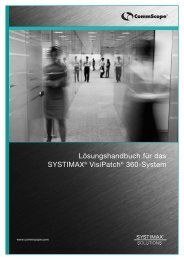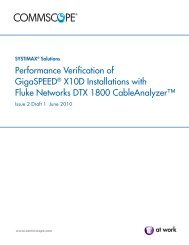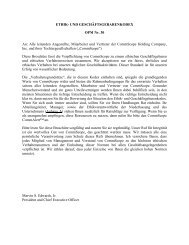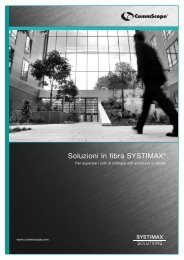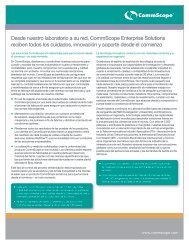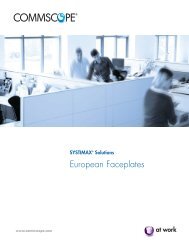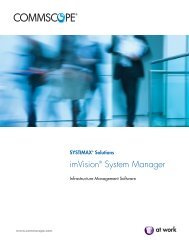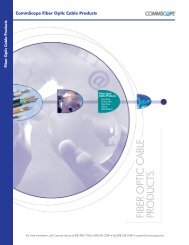Enterprise Design Guide - Public - CommScope
Enterprise Design Guide - Public - CommScope
Enterprise Design Guide - Public - CommScope
You also want an ePaper? Increase the reach of your titles
YUMPU automatically turns print PDFs into web optimized ePapers that Google loves.
Coaxial Cable Operating Standards and Performance<br />
While coaxial cable was once the media of choice for data networking, its merits of fairly low<br />
attenuation and excellent protection from RF interference have been superseded by twisted pair<br />
and fiber. It is still the media of choice for video distribution.<br />
Coaxial cable is in effect a waveguide; it efficiently channels radio/TV frequencies and is<br />
capable of carrying hundreds of different frequencies simultaneously. It is an ideal media for<br />
video transmission and for linking to satellite and microwave dishes. Coax is also used to<br />
transport signals between the hubs and remote antenna units that power wireless networks.<br />
Conductor materials vary per application; CCTV cables use solid bare copper while CATV<br />
cables use copper-clad steel conductors.<br />
Impedance<br />
Impedance is the resistance to current flow of the cable measured in ohms (Ω). The nominal<br />
impedance of the transmitter, receiver and cable must match precisely for a system to work at<br />
maximum efficiency. An incorrect match will produce return loss. Video cable is 75Ω; other<br />
values used are 50Ω and 93Ω.<br />
Attenuation<br />
Attenuation is the limiting factor for coax cable with higher transmission frequencies being more<br />
affected. Specifications are usually written with the maximum available loss in decibels per<br />
100 feet or 100 meters for a set of frequencies. Cables with larger diameter center conductors<br />
tend to have lower attenuation.<br />
Velocity of propagation<br />
Another performance factor is the velocity of propagation (VP), or how close to the speed of<br />
light the signal travels. Higher numbers are better. <strong>CommScope</strong> video coax generally uses a<br />
foamed dielectric material that significantly increases VP.<br />
Return loss<br />
Return loss is the ratio of the power of the outgoing signal to the power of the reflected signal<br />
expressed in dB. Structural return loss is the measure of power loss on a cable caused by<br />
discontinuities in the cable conductor or dielectric. If these discontinuities are regularly spaced<br />
along a cable, they can cause severe transmission losses for frequencies whose wavelengths<br />
are fractional proportions (1/2, 1/3, 1/4, etc.) of the distance between these discontinuities.<br />
Lower numbers are better in both cases.<br />
Coax is a viable media for industrial networking, especially in areas where the electromagnetic<br />
interference (EMI) created by electrical motors and manufacturing processes such as arc<br />
welding would render an unshielded cable useless. Protocols like ControlNet TM and MAP<br />
specify coaxial media.<br />
Look for the lowest possible<br />
attenuation for the intended<br />
operating frequencies<br />
www.commscope.com 33



